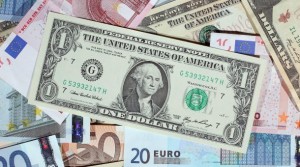 Yesterday’s trade saw EUR/USD within the range of 1.1271-1.1378. The pair closed at 1.1316, edging up 0.23% on a daily basis. It has been the 16th gain in the past 29 trading days, but also the slowest one since January 27th, when the pair added 0.19%. The daily high has been the highest level since October 21st, when a high of 1.1380 was registered.
Yesterday’s trade saw EUR/USD within the range of 1.1271-1.1378. The pair closed at 1.1316, edging up 0.23% on a daily basis. It has been the 16th gain in the past 29 trading days, but also the slowest one since January 27th, when the pair added 0.19%. The daily high has been the highest level since October 21st, when a high of 1.1380 was registered.
At 8:27 GMT today EUR/USD was losing 0.37% for the day to trade at 1.1274. The pair touched a daily low at 1.1265 at 8:20 GMT, undershooting the lower range breakout level (S4), and a daily high at 1.1333 during early Asian trade.
On Friday EUR/USD trading may be influenced by the following macroeconomic reports as listed below.
Fundamentals
Euro area
Italy – Gross Domestic Product – preliminary estimate
The preliminary estimate of Italys annual Gross Domestic Product probably pointed to a 1.2% expansion in the fourth quarter of the year, according to the median forecast by experts. If so, this would be the fastest annual rate of growth since Q4 2010, when Italian GDP rose 1.5%. In Q3 economy grew at an annualized pace of 0.8%, according to final data, released on December 1st.
On a quarterly basis, Italian economy probably expanded 0.3% in Q4 2015, according to market expectations, following a final 0.2% growth in the third three-month period of the year. In Q3 household consumption and a rise in inventories were the main driving factors behind growth, while negative trade flows continued to obstruct economy. Final consumption expenditure rose 0.4% in Q3, following a 0.2% increase in Q2, and added 0.3 percentage point to Italian growth. Inventories expanded for a third successive quarter in Q3 and contributed 0.3 percentage point to growth. On the other hand, fixed investment contracted 0.4% in Q3, following a 0.1% drop in the second quarter, and subtracted 0.1 percentage point from growth. The major factor behind lower fixed investment was the 0.9% drop in spending on machinery, equipment and miscellaneous products in Q3.
In case a faster-than-projected rate of growth is reported, this will have a moderate bullish effect on the single currency. The National Institute of Statistics (Istat) will release the preliminary GDP data at 9:00 GMT.
Eurozone – Gross Domestic Product – preliminary estimate
The seasonally adjusted preliminary Gross Domestic Product in the Euro area probably expanded at an annualized rate of 1.5% during the fourth quarter of 2015, according to expectations, following another 1.6% increase of the GDP in the third quarter, according to final data. If so, this would be the fastest annual rate of growth since Q1 2011, when the regions economy expanded 2.5%.
The preliminary GDP in Q4 2015 compared to the third quarter probably remained flat. In Q3 compared to Q2 the regions economy grew at a final rate of 0.3%, matching the preliminary rate reported on November 13th.
Household final consumption expenditure went up 0.4% in the Euro area and 0.5% in the EU28 in Q3, following a 0.3% and 0.4% expansion respectively in the second quarter of 2015. Gross fixed capital formation was stable in the Eurozone and increased 0.3% in the EU28 in Q3, following a 0.1% and 0.4% expansion respectively in Q2. Total exports went up 0.2% in the Eurozone and 0.3% in the EU28 in Q3, following a 1.6% and 1.3% expansion respectively in the prior quarter. Total imports were 0.9% higher in the Eurozone and 1.4% higher in the EU28 in Q3, following a 0.9% and 0.3% increase respectively in the previous quarter, according to the report by Eurostat.
Household final consumption expenditure contributed positively to GDP growth both in the Eurozone and the EU28, adding 0.2 and 0.3 percentage points respectively. Gross fixed capital formation was neutral in the Eurozone, but contributed positively to GDP growth in the EU28, adding 0.1 percentage point.
In case economic growth in the single currency zone exceeded expectations in Q4, this would certainly boost the euro. Eurostat is expected to release the preliminary GDP report at 9:00 GMT.
Industrial Output
The seasonally adjusted index of industrial production in the Euro area probably rose 0.3% in December compared to a month ago, according to market expectations, following a 0.7% contraction in November. The latter has been the sharpest monthly rate of decrease in output since August 2014, when it shrank at a revised up rate of 1.4%.
Annualized output probably increased at a pace of 0.9% in December, according to the median forecast by experts. If so, this would be the 13th consecutive month, when annual output grew. In November industrial production expanded 1.1% year-on-year, or at the slowest rate in seven months. Novembers index performance was boosted by production of intermediate goods (up 2.1% year-on-year), durable consumer goods (up 1.7%) and capital goods and non-durable consumer goods (both up 1.2%). Production of energy, on the other hand, contracted 2.8% in November from a year ago.
The index, reflecting the business cycle, measures the change in overall inflation-adjusted value of output in sectors such as manufacturing, mining and utilities. In case annualized industrial output expanded at a faster rate than anticipated, this would have a moderate bullish effect on the euro, as it implies a greater probability of inflationary pressure occurring. Eurostat is to publish the official data at 10:00 GMT.
United States
Retail Sales
Retail sales in the United States probably increased 0.1% in January on a monthly basis, according to the median forecast by experts. In December sales unexpectedly fell 0.1%, following five consecutive months of increases.
Among the 13 major categories, 6 registered growth, 6 showed declines and 1 showed no change. In December, an increase in sales was reported for sporting goods, hobby, book & music stores (up 0.9% month-over-month), furniture stores (up 0.9%), food and services drinking places (up 0.8%), building material and garden equipment and supplies dealers (up 0.7%), non-store retailers (up 0.3%) and health and personal care stores (up 0.2% from a month ago).
On the other hand, in December, retail sales dropped at miscellaneous store retailers (down 2% month-over-month), gasoline stations (down 1.1%), general merchandise stores (down 1%), clothing stores (down 0.9%), food and beverages stores (down 0.3%) and electronic appliance stores (down 0.2% from a month ago).
Sales at motor vehicle & parts dealers remained unchanged during the same month, according to the report by the US Census Bureau.
Annualized retail sales surged 2.2% in December, or the most since September 2015, following a revised up 1.6% climb in November.
US core retail sales, or retail sales ex autos, probably remained flat in January compared to a month ago, following a 0.1% dip in December. The latter has been the first drop in the past three months. This indicator removes large ticket prices and historical seasonality of automobile sales.
In case the general index came above market expectations in January, this would have a strong bullish effect on the US dollar. The official report is due out at 13:30 GMT.
Import and Export Prices
Prices of imported goods in the United States probably fell for an 8th consecutive month in January, going down at a monthly rate of 1.2%, according to market expectations. In December import prices were again 1.2% lower from a month ago, driven by a 9.5% slump in fuel prices. Non-fuel prices were down 0.3% during the same month. In annual terms, prices were 8.2% lower in December, which has been the 17th consecutive month of decline. Generally, lower import prices of goods suggest lower rates of consumer inflation.
Prices of exported goods from the United States probably decreased for an 8th consecutive month in January, falling at a monthly rate of 0.6%. In December export prices were 1.1% lower from a month ago, as agricultural export prices fell 1.0%, while prices of non-agricultural goods dropped 1.1%. In annual terms, export prices slumped 6.5% in December, or for a 16th month in a row. Lower prices of exported goods generally bolster demand abroad, and as US trade accounts for 20% of international trade relations, this also tends to be dollar positive.
The Department of Labor is expected to release the official numbers at 13:30 GMT.
Reuters/Michigan Consumer Sentiment Index – preliminary reading
The monthly survey by Thomson Reuters and the University of Michigan may show that consumer confidence in the United States improved in February. The preliminary reading of the corresponding index, which usually comes out two weeks ahead of the final data, probably rose to 93.0 during the current month from a final reading of 92.0 in January. The latter came well below the preliminary reading of 93.3, which was reported on January 15th. If expectations were met, Februarys reading would be the highest since July 2015, when a level of 93.1 was reported.
The sub-index of current economic conditions advanced to a final reading of 106.4 from a preliminary 105.1 in January, but down from a final 108.1 in December.
The sub-index of consumer expectations came in at a reading of 82.7, down from a preliminary value of 85.7 in January, but matching the final reading registered in December.
Participants in the January survey expected that the rate of inflation will be at 2.5% during the next year, or higher compared to the preliminary release (2.4%), but down from a rate of 2.6% as expected in December.
In case the gauge of consumer sentiment increased at a steeper pace than projected in February, this would have a moderate-to-strong bullish effect on the greenback. The preliminary reading is due out at 15:00 GMT.
Daily and Weekly Pivot Levels
By employing the Camarilla calculation method, the daily pivot levels for EUR/USD are presented as follows:
R1 – 1.1326
R2 – 1.1336
R3 (range resistance) – 1.1345
R4 (range breakout) – 1.1375
S1 – 1.1306
S2 – 1.1296
S3 (range support) – 1.1287
S4 (range breakout) – 1.1257
By using the traditional method of calculation, the weekly pivot levels for EUR/USD are presented as follows:
Central Pivot Point – 1.1072
R1 – 1.1333
R2 – 1.1506
R3 – 1.1767
S1 – 1.0899
S2 – 1.0638
S3 – 1.0465





